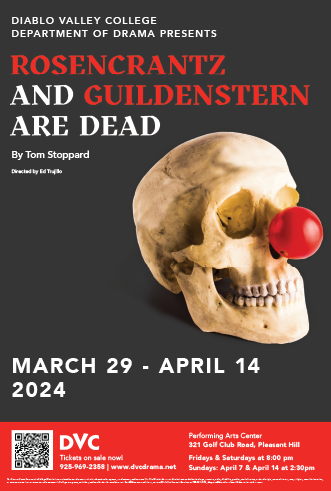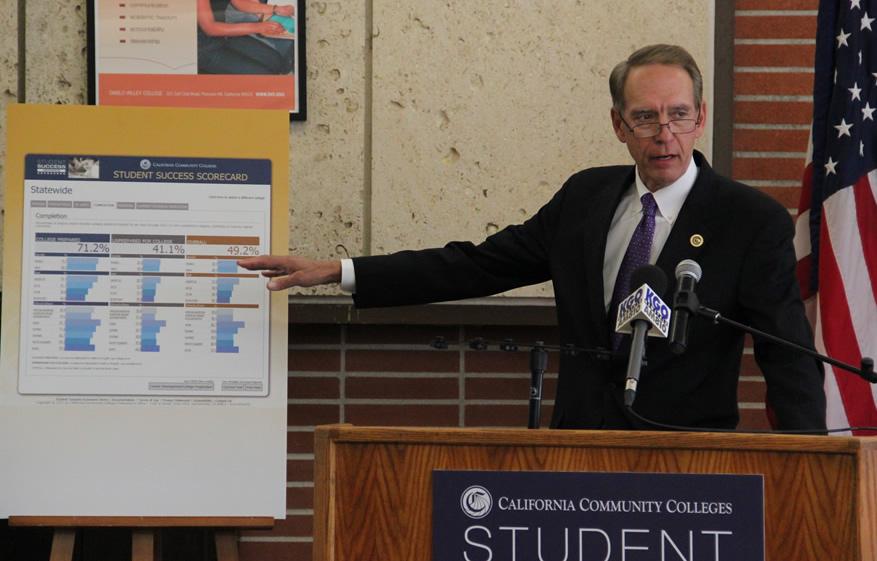DVC will be the first of California’s 112 community colleges to carry a school report card. California Community College Chancellor Brice W. Harris made Diablo Valley College his first stop in a tour of the state highlighting the features of the system designed to measure school and student success.
Harris briefed the standing-room-only crowd assembled in the DVC Trophy Room where DVC President Peter Garcia introduced the Chancellor, extolling the comprehensiveness of the card, saying that compiling data and statistics from 112 different schools was a tedious process, but “one that was very much needed.”
The scorecard is one product of the Student Success Act of 2012, a bill authored by Sen. Alan Lowenthal, (D-Long Beach) in response to sub-par findings by a former state community college Chancellor’s troubleshooting committee called the Student Success Task Force, who have continued sights on improving student transfer rates.
Though not entirely original (see President Obama’s College Scorecard), the Student Success Scorecard builds on statistics and performance tracking, generated by a network of state and school departments known as the Accountability Reporting for the Community Colleges (ARCC).
The scorecard represents the first formal attempt by California’s community colleges at easing access to standardized information for students wanting to evaluate campuses or compare two-year schools. The chart, accessible through a website, will enable students to see school certificate and degree attainment, as well as graduation and transfer rates. According to Harris, the scorecard will track data on outcomes by race, ethnicity, gender and age.
The state is betting on the positive results of a smaller experiment that more information equals better planning, which will translate into better completion. “The initial scorecard results make it clear how important preparation is for college success, showing that if students come to college well prepared, the complete certificates, degrees, or transfer at rates exceeding 70 percent. However, if they need remediation, their success rate drops below 50 percent,” Harris said.
Students were initially supportive of the scorecard itself. Second year student Amanda Seaborne explained, “It would be a good thing. I’ve looked for transfer rates before, but it was harder to find that information.” But others were concerned the scorecard wasn’t obviously accessible on DVC’s website. “When you look at a school, one thing I look at is dropout and success rates. The university I went to back in Indiana had it right on their website.” said Drama major Brittany Fritts.
While arming prospective students to make informed choices is generally viewed as a good thing, the added transparency isn’t without potential pitfalls.
If Gov. Brown’s proposal to shift community college funding based on enrollment to funding based on completion winds up getting support, increased transparency may further incentivize community colleges to cut more advanced classes in an attempt to raise their average.
While the added transparency has been well received, it appears limited to student statistics, avoiding college spending statistics, figures discerning students would have to dig deeper for. The college scorecards wouldn’t include school budget summaries, teacher salaries, school equipment, or loan information. And while there is tracking for students in vocational courses, there wasn’t information for job placement.
It wasn’t clear what the scorecard would mean for community colleges with more economically disadvantaged students already struggling with low transfer rates. Though, the potential for shopping students to balk at a bad college grade and take their enrollment elsewhere appears to be a potential risk.
According to the scorecared, which went live today, DVC’s average transfer rate was 61%, which was a healthy bit over the local average, but only time will tell how the scorecard may impact enrollment or funding.
The Student Success Scorecard website can be accessed at http://scorecard.cccco.edu/scorecard.aspx







































































